The Water Horse Land Sightings at Loch Ness
Posted by: Loren Coleman on December 22nd, 2007
The Water Horse Land Sightings at Loch Ness
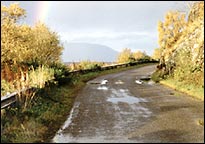
On this section of the autoway around Loch Ness, an eyewitness once saw an unknown creature cross the road.
The dirty little secret that drives two groups – the closed minded debunkers and the plesiosaur true believers – totally mad is the file on land sightings of cryptids at Loch Ness. Some researchers would just as soon completely ignore them versus looking at what the encounters mean if they are evidence of cryptids unknown in and out of the Scottish lake.
The usual reaction has been one in which ridicule is used when talking about the land sightings. For example, the following cartoons, even if well-done and humorous, have been posted in conjunction with discussions of the two more famous Loch Ness land sightings of 1933 and 1934:
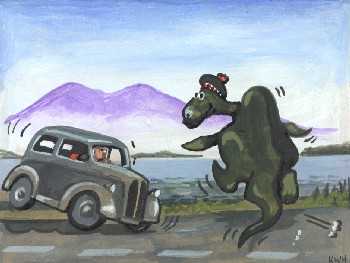
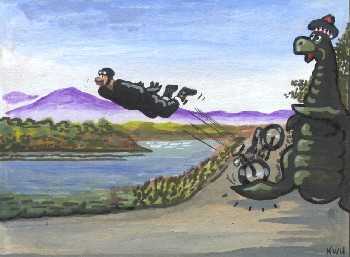
A Loch Ness Monster skeptic once asked me, “Do you really believe the land sightings?”
I answered him directly, per usual, this way: You shock me, as you must know that I don’t “believe” in anything to do with Loch Ness cryptids, as that word speaks more to religious fervor and blind evangelical faith, which I feel has little place in cryptozoology, except to characterize how some “researchers” approach the subject.
I accept that patterns develop from looking at the data. Indeed, it continues to amaze me that the “Nessie skeptics” refuse to be open-minded about looking at all the sightings, in an attempt to learn where the information might take one in examining and analyzing the available data on this probable natural history phenomenon.
Okay, I’m not sure what to make of some of the “land sightings” at Loch Ness, but I am not for throwing them all out with the bath water, that’s for sure.
Obviously, what appears in my and Patrick Huyghe’s book The Field Guide to Lake Monsters, Sea Serpents, and Other Mystery Denizens of the Deep (NY: Tarcher/Penguin, 2003), gives my overview of what I think about this matter (US & UK).
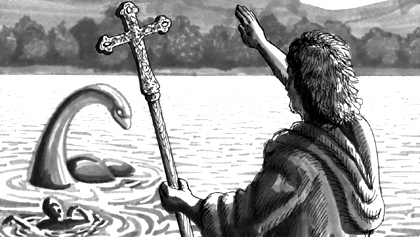
After the account by St. Columba in the 5th Century, which may or may not be technically a good, out-of-the-water sighting, I turned to the highlights of the history of Loch Ness land sightings.
Specifically, you will find on pages 80-83:
“In terms of the history of Lake Monsters, especially the Waterhorse, none outshines that of the Loch Ness Monsters, which naturally issue from the Water-kelpie traditions. While the history of Nessie is well known (see pages 18-22), less well known are the remarkable encounters with Nessies that have taken place on land. These accounts provide a close-up view of the Waterhorse, unobscured by murky waters.
“In 1771 someone spotted a monstrous creature ‘which was a cross between a horse and a camel’ near Loch Ness. Children playing at Ness’ Inchnacardoch Bay in 1912 told of seeing, from no more than a few yards’ distance, an animal that looked like a long-necked camel. It entered the water, then disappeared into the waves. Two other land reports at Loch Ness, from 1923 and 1933, compared the creature to a giant hippopotamus.
“Mike Dash, an investigator and author, has pointed out that one of the less-discussed topics about Loch Ness and Lake Monsters is the relatively modern history of over 20 land sightings at Loch Ness, and over 30 other such eyewitness accounts elsewhere. Land sightings, for example, are also known for creatures seen in Seljordsvatnet in Norway and Storsjøn in Sweden, as well as for several lakes in Ireland. Dash, an open-minded skeptic, feels that the paucity of land sightings since the thirties proves that the phenomenon of Nessie is more myth than monster. But a closer analysis of the data reveals that other factors may be at play.
“In April 1932, Colonel L. MCP Fordyce, came forth and told how he and his fiancée were traveling near Loch Ness, from Kent to Aberdeen, when they saw an enormous animal come out of the woods and cross the road about 150 yards ahead of their car. ‘It had the gait of an elephant, but looked like a cross between a very large horse and a camel with a hump on its back and a small head and long neck. From the rear it looked grey and shaggy. Apart from scanning the national papers for some time in search of mention of the creature, we let the matter rest.’
“Further confirmation, in the form of other land sightings, would come quickly during the next several months. In August 1933, Mrs. M.F. MacLennan saw a dark gray, humped animal with short, thick legs, on the beach near Dores. It appeared to be about 18 to 23 feet (6 to 7.5 meters) long. In December 1933, Mrs. Ried near Inverfarigaig saw a creature resting on shore about the size of a hippopotamus, with a hairy body, a thick mane on its neck, a round, large head, and with thick, short legs.
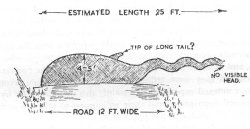
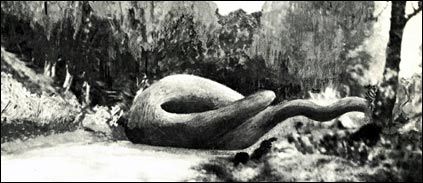
“Next came a classic sighting on par with the Spicers (see case, pp. 99-101). [Images of the Spicers’ sighting are above.] On the brightly moonlit night of January 5, 1934, at about 1:00 A.M., a young medical student named Arthur Grant was riding his motorcycle along the loch road near Lochend, when he saw a large dark object on the road ahead [images below]. As he approached, the animal ran across the road, almost colliding with Grant. In the moonlight, he saw an animal with a small eel-like head that had oval eyes, a bulky body with a broad tail, and four seemingly legs ending in flippers. He estimated it was about 18 to 20 feet long and had dark whale-like skin.
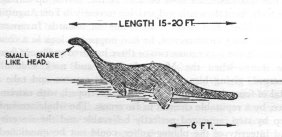

“‘Knowing something of natural history I can say I have never seen anything in my life like the animal I saw,’ Grant was quoted as saying in Peter Costello’s In Search of Lake Monsters. ‘It looked like a hybrid a cross between a plesiosaur and a member of the seal family.’
“Before 1933, the record shows land sightings of the Waterhorse of Loch Ness in 1527, 1879, 1880, 1890, 1912, 1919, and 1923. This would be seven in four hundred years. Some of the pre-1930s land sightings are spectacular, such as the 1880 Drumnadrochit encounter between E. H. Bright and a four-legged, long-necked, dark-grey monster that came out of a wooded area and went into the loch. Or the 1912 Inchnacardoch Bay encounter between William MacGruer and a yellowish, long-legged, camel-like beast that moved into the loch.
“But in general, most of the land sightings occurred in the 1930s – ten within two years, in fact. Why? As noted in the introduction, it happened just as the area was being deforested and the road around the loch was being upgraded. Views of the loch improved dramatically. Travel around the loch was easier. Media interest was at a peak. People were being forthcoming about what they were seeing–at least until the subject became a subject of ridicule both by the media and by scientists.
“During the 1930s, Alec Muir saw a large beast cross the road in front of his car at Inverfarigaig, and a group of school children saw what one of them called a ‘horrifying’ animal move from a swampy area to Urquhart Bay. Before the Spicer-Grant series of sightings, Mrs. Eleanor Price-Hughes told of seeing a large creature coming from the bushes with something pink (salmon?) in its mouth, and vanish into the water of the loch.
“During February 1934, a month after Grant’s sighting, Jean MacDonald and Patricia Harvey saw a thick-bodied creature that was more than six feet long crossing a stream near Inchnacardoch Bay in moonlight. It appeared to be dark above and lighter underneath, with four thick, short legs. In June 1934, Margaret Munro, at the shingle beach at Borlum Bay, sighted a large, dark gray body with a giraffe-like neck and small head. It seemed to have two short forelegs or flippers.
“Why isn’t Nessie reported on land anymore? Has the population of Nessies dwindled over the years, as some researchers believe? Or is there a human reluctance to report such a fantastic encounter?
“In the end, as chemist and Nessie sympathizer Henry H. Bauer observes, ‘One is brought squarely up against the phenomenon of apparently responsible and plausible individuals who insist on the reality of experiences of the most extremely improbable sort.'”
Will this new movie increase the interest in the land sightings too?
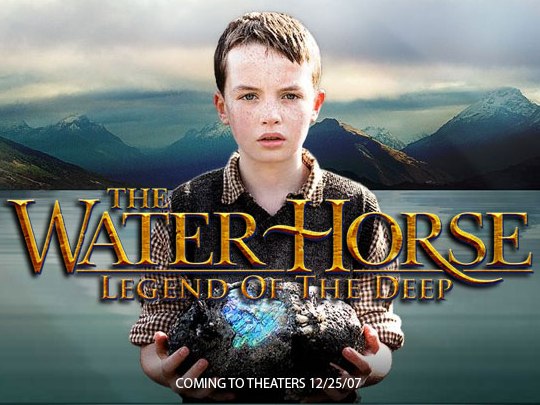
+++
Text © 2003, 2007. Loren Coleman and Patrick Huyghe. All rights reserved.
Cartoons © A G Harmsworth.
St. Columba art © William Rebsamen.
+++
About Loren Coleman
Loren Coleman is one of the world’s leading cryptozoologists, some say “the” leading living cryptozoologist. Certainly, he is acknowledged as the current living American researcher and writer who has most popularized cryptozoology in the late 20th and early 21st centuries.
Starting his fieldwork and investigations in 1960, after traveling and trekking extensively in pursuit of cryptozoological mysteries, Coleman began writing to share his experiences in 1969. An honorary member of Ivan T. Sanderson’s Society for the Investigation of the Unexplained in the 1970s, Coleman has been bestowed with similar honorary memberships of the North Idaho College Cryptozoology Club in 1983, and in subsequent years, that of the British Columbia Scientific Cryptozoology Club, CryptoSafari International, and other international organizations. He was also a Life Member and Benefactor of the International Society of Cryptozoology (now-defunct).
Loren Coleman’s daily blog, as a member of the Cryptomundo Team, served as an ongoing avenue of communication for the ever-growing body of cryptozoo news from 2005 through 2013. He returned as an infrequent contributor beginning Halloween week of 2015.
Coleman is the founder in 2003, and current director of the International Cryptozoology Museum in Portland, Maine.










The Wall Street Journal yesterday gave a very good advance review to The Water Horse, calling it a family film with wit and heart.
After the Water Horse film. I think something big is going to happen in Loch Ness.
A cow moose (or Irish elk) resembles a cross between a horse and a camel.
The other sitings don’t sound much like an Irish elk, though. I suppose that we don’t know if plesiosaurs were amphibious. They did breath air, though. If they weren’t viviparous, they would have had to come to land, just like turtles, to lay their eggs.
If there are long-necked seals or sea lions, where do they have their rookeries? Are there any pinipeds which are solitary?
Don’t quote me on it, sschaper, but I am pretty certain that leopard seals don’t have rookeries. I could be wrong, though, I haven’t read anything on pinnipeds other than fossil species in a while.
Since this is by the same producers of The Chronicles of Narnia, it should be an outstanding production and I am looking forward to seeing it over the holidays. It can’t help but create a burgeoning interest in Loch Ness! I also enjoyed Beowulf although some of the characterizations were a tad off in my opinion, however, I guess that is a subject for another thread, but these animated films seem to be headed in the direction of entertainment not just for children, but also adults and a good thing.
I’ve always enjoyed the tales of the land sightings and even more the tales of how even the most open minded believers try to explain them away. Sightings of things that look like camels, hippos, salamanders, frogs, Loch Ness is truly a strange place.
AMEN! 🙂
Thanks for a post about such an important–but highly neglected (perhaps for the reasons you suggest)–aspect of the Nessie (and, presumably, most/all “Lake Monsters”) phenomenon. It seems that what’s important in this discussion–and really all discussions involving cyrpozoology–are the data. One cannot pick and choose to promote or highlight one part of the data while willfully ignoring other elements. “Believers” (sorry to use that word!) and skeptics alike tend to do so, on occasion.
I found it interesting that you used a religious connotation for the term “believe in [Nessie]” in answering the Loch Ness Skeptic at the beginning of the post. I’ve always felt that the most resonsible position to take (in terms of crypozoology) is rather akin to the religious viewpoint of the agnostic, one who niether believes or disbelieves (even when the data strongly suggest there is really something there).
Mammal? Plesiosaur? Let’s hope that the new film will, indeed, renew interst in Nessie and other Lake Cryptids, and that perhaps a long-delayed discovery of one somewhere will then occur.
I often wonder what is behind the word “believe” that raises the hackles of some people. The religious context of the word is not the only meaning of it. Sure, you can use it in a religious context, but it also means to accept as true, genuine or real and I, for one, will continue to use it when I choose. There is absolutely nothing wrong with it.
Of course, as Ms. Green states, anyone can use words in any way they wish.
However, for me, within the context of cryptozoology, regarding, especially, media interviews and challenges from skeptics, I have to be very clear about the role of science and not belief in my responses.
I was always fascinated with the land sightings. An ability to hump-it overland for short distances would explain how a modest population of animals seems to have representatives in so many different bodies of water. Would also explain sightings of animals in Irish loughs, many of which are too small to host a permanent visitor but could accomodate the occasional transient.
it’s been a long time since there’s been a sighting of nessie on land. it’s nice to know she’s still here.
See, the land sightings, in my view, damage, pretty seriously, the case for an unknown species of large animal in Loch Ness.
Or, on the other hand, they raise the possibility of a menagerie of large unknown animals in Loch Ness.
What we have here is a sauropodian pinniped with a long neck, a cross between a horse and a camel. That catches salmon in the bushes and takes them into the water. Very reminiscent, in fact, of a giant hippopotamus. With an elephant’s gait, an eel-like head, and whale-like skin, that is heavily furred, and maned like a lion’s. And very long, very short legs.
“Totally mad”?
Oh, I would say so.
I can tell you what a sasquatch looks like, and how big they are. And I’ve never seen one. But I have no idea what all 50 of this one unique animal in Loch Ness look, or looks, like.
Or, um, doesn’t.
Oh. Forgot toad and frog. Toss them in there too.
I recall seeing a black and white picture of “Nessie on land” and at night, somewhere. It purports to show a large mass of flesh on a rocky shore that could very well be a large rounded rock. It is not one of the more popular pictures, no doubt, due to the difficulty of accepting what it shows.
Tae much single-malt tends ta confoos th’ reportins. 😉
(this is not a statement on cryptozoology, but in response to an earlier humorous post about what the critter looks like, based on compiling the different reports over time)
I’m quite intrigued by Richard888’s claim of there being a photograph which is said to show the Loch Ness Monster on shore. I know of very many photographs from Loch Ness but I must admit that I never found any references to the one referred to. Apart from the LNI’s film from 1963, which supposedly depicts a large unidentified object on the opposite shore (or in the shallows thereof); I am unaware of any similar photo or film evidence.
However, the description of a ‘large mass of flesh’ photographed at night sounds like the object in the black and white photo taken by Peter O’Connor near the shore (at Foyers) back in 1960. Could it be that particular photo?
There was also a recent colour photograph published, which purported to show some sort of a carcass in the shallows of the Loch, which obviously was a tree branch. The photo was supposed to be taken on 20th of August, 2002 by Tobias Beitz and Claudia Erwin.
And finally, the only black and white photo that is said to show a lake monster on land – to my knowledge – is the one taken near Lough Sraheens (Achill Island) in Ireland. It too was taken in 1960 and it seems to depict a ‘monster’ that bears some resemblance to the extinct stegosaur. US investigator, Nick Sucik, was the first researcher who has published this long forgotten photo. It can be seen at his excellent website: http://www.mysteryanimalsofireland.com/photos.htm
Nick has done a tremendous amount of research into the Irish ‘mystery animals’, and he is of the opinion that the photograph was faked. Indeed, a few years ago I have tried to make a reconstruction of it by using a small dinosaur model, and to my satisfaction the resultant photograph was very similar to the original.
I agree it’s not proper to reject the land reports a priori, and there’s no reason a water animal can’t be at least occasionally amphibious, as so many creatures from true amphibians to sea otters do straddle the land/water boundary from one direction or another. That said, they do make me uneasy. It is hard enough to believe (though not impossible) that the hunt for a water animal perhaps 10m long in a large but finite lake has not yielded more conclusive evidence by now: it’s that much harder to accept if the animal occasionally ventures on land, where it should leave distinctive tracks or marks of some kind.
I’ve never put stock in the idea that the Ness animals, whatever they are, habitually travel between lakes. There should be many more good land sightings than we have, and more bodies, either having been shot, hit by vehicles, stabbed with a pitchfork, or whatever.
Travel between lakes have never interested me as much as the speculation that routine, regular, or significant cycles of transport might be occurring between the marine environments and the freshwater ones. Whether this migration might be annual or of a longer cicada-type cycle, whether for breeding or spawning or eating, is unknown to me.
But I’ve thought an exploration of these possibilities, re: movement between the sea and loch, might be worth exploring.
Animals adapted to a life in the cold and dark, such as the silt bottom of these glacially associated lakes, of which Loch Ness is a fine example, might stay submerged in a torpid state waiting for an environmental/metabolic signal to move in response to food or reproductive instinct.
That they are confused with other more common animals is understandable as is the eccentric periodicity of their appearance since it might be in sync with some natural cycle that’s so far gone unnoticed in the environmental record. Not too hard to believe considering how scatter-shot and relatively short-term some of the understanding of nature’s complex patterns have been to date.
Might this also explain how a sparse population would survive and sustain itself without a regular exploitable kind of behavior that researchers could detect in surveying the lake with the methods they’ve been using.
This always makes me wish I had a cow carcass, an anchor and a boat and an underwater camera with a long time lapse function….hmmm, might be tough to get on the airplane too.
>> Animals adapted to a life in the cold and dark, such as the silt bottom of these glacially associated lakes, of which Loch Ness is a fine example, might stay submerged in a torpid state waiting for an environmental/metabolic signal to move in response to food or reproductive instinct.
Sorry, part of my last post seems to have been chopped off. I was asking if we had any known examples of large aquatic animals making this adaptation.
Matt; a quick view of the wiki for hagfish will reveal some interesting aspects to their particular life pattern which I find relevant to glacial lake habitat, but what everything primarily draws attention to is how little is actually known about ’em since they are so far removed from areas with which we are familiar.
No suggestion that they have an indeterminate growth pattern that would allow ’em to grow to enormous size, but then again so little is known, and other eel like vertebrates can bet pretty big with one suggestion that they represent a particular morph of species of eelpout in which sexually precocious and possibly hermaphroditic individuals leave the mainstream and expand the species range by entering promising freshwater sources in search of the muddy habitat they require. Lots of speculation, to be sure, but when it comes to the abyssal plain there’s lots of room for speculation and nature still surprises us.
Very interesting. Anyone every read the Waterhorse land sightings in Ted Holiday’s Goblin Universe?
A few observations…
1. The Ness land sightings are generally problematic and cannot be reduced to simple “data”. Many sightings are much more akin to “twice-told tales” than field reports. Such stories lack fundamental information, such as names and dates, confirming evidence, personal information about the sighters, etc. Also, most of the sightings are recorded by advocates who are not too interested in contradicting the accounts.
2. The sightings are largely inconsistent. (See DWA’s pointed post above to this effect.)
3. Even the best sightings are altered and embellished in their retelling. For instance, in our kind host’s account of the Arthur Grant sighting, Grant saw an animal cross the road with “four seemingly legs ending in flippers.” Yet, I recall reading Grant’s earliest account and he pointedly stated he did not see legs, feet, or any other mode of transportation concerning the animal he saw. The earliest sketch of Grant’s creature did not show legs or flippers.
4. Most land sightings seemed to be bunched around the founding events of the early 1930’s. This may imply that such sightings were influenced by sudden and new accounts of a “monster” in the loch (suggestibility and imagination at play).
5. As noted in the original post above, it is suspicious that so few land sightings have been noted. Either Nessie travels across land or not. If she does, more sightings and evidence of it should have been accumulated by now.
A note concerning the founding events at Ness in the early 1930’s.
I’m surprised that advocates and skeptics alike have largely ignored what I take to be a major revelation: a monster in Ness was a PR stunt!
In Bauer’s “Enigma” book, he recounts a reference he ran across concerning a transplanted public relations officer. The fellow was from British Columbia transplanted to England. The officer stated in his memoirs that, hired to boost tourism at Ness, he had created a monster in Ness based on his remembrance of stories of a lake monster in B.C. (“Ogopogo” anyone?) He had planted the original story of “something big” in the loch (and remember, the original news report came from a married couple who were Ness inn owners!) Bauer did not discount this story (although he didn’t think it important).
If the story is true, we have an explanation for the sudden appearance of a “monster” in the loch in the 1930’s. And by extension, we could suggest that ensuing events at Ness were part enchanted imaginations, part-hoax, and a demonstration of the lovely human will to (yes) BELIEVE.
Actually, as I mention in my and Patrick Huyghe’s field guide, the first reference to a lake monster sighted in Loch Ness during the era in question can be traced to the Inverness paper, the Northern Chronicle, for August 27, 1930, three years before that couple’s sighting launched the big media flap of 1933.
This 1930 sighting would seem to undermine any notion that the Loch Ness Monster was a publicity stunt promoted by a British Columbian arriving lochside in 1933.
jerrywayne: your post is an excellent example of the lovely human will to, yes, believe.
Nessie’s been around for centuries. Trying to explain the whole thing away with one incident in the 1930s strikes me as, well, pretty credulous. (Ogopogo post-dates Nessie by centuries. Everyone knows that, at least so I thought.)
A skeptical mindset comes up with an alternative explanation for ALL the Nessie evidence. Or it really isn’t skeptical, just negatively cross-fingers-and-toes hopeful.
DWA,
Nice trick. The skeptic is the believer. The believer is the skeptic. (Reminds me of “scientific creationism” land, where religion is science and science is religion). Up is down, too.
Your matter of fact “Nessie’s been around for centuries” is, well, no matter of fact. It is more accurate to conclude that “Nessie” as a phenomena originated in the early 1930’s, and the year 1933 is usually attributed as the founding year of the “monster” myth. Once the story appeared in the local paper (perhaps planted) concerning an large animal seen in the loch (perhaps a PR event), people began seeing the monster on land and in the loch, and even a couple of (now considered dubious) photos were taken. The fact is that more sightings of “Nessie” occurred in 1933 than any year since may suggest we are dealing with imaginations excited by rumors and current events, not long standing knowledge, centuries old, of a lake monster.
Nessie advocates themselves have recognized this issue as a potential problem. They offer this scenario: the loch was a forlorn, remote place until a loch side road was created in the early 1930’s which allowed more people than before to see the loch. Problems with this scenario have been noted. First, the loch was a tourist destination in the 1800’s. It even had large boat trips for those who could afford them. Second, survey maps show that the loch side road had been there prior to the 1930’s.
That there are “monster” sighters before the 1930’s is equally problematic. First, many of the alleged accounts came to light AFTER the “flap” of 1933. One could plausibly make the case that the “flap” was the cause of “the twice-told tales”.
For instance, amid the 1933 excitement, a letter appeared in a Scottish paper claiming a large fish had been seen in the loch in 1520, 1771, and 1885. No evidence was given for the claim
If it was known that Ness harbored a “monster” for centuries, we would expect a cultural influence in music and story through the ages in the Highlands. We do not, unless you want to conflate water horses and kelpies (Highland supernatural boogies that kept children away from the lochs) with a flesh and blood animal.
The St. Columbia event is found in a folkloric book that was full of fabulous stories. I honestly don’t know how advocates can use this “evidence” with a straight face.
Of course the Ness story is more complex than a planted story. I wouldn’t suggest otherwise. I make the point of a possible PR event as the IMPETUS that got the whole story going. The excitement of belief moved it along, putting doubt to the side.
You speak of “alternatives” to the “evidence” that must be proposed by skeptics. As usual, I think you put the cart in front of the (water)horse. Give me a credible piece of evidence for a large, unknown animal in Ness. Then we can talk about “alternatives”.
Kind Host,
I have read a couple of your books and have found them entertaining. I did not read your co-authored book on lake monsters. I probably shouldn’t put my neck out like this, but I vaguely recall a source that suggested the sighting reported in 1930 in a paper was written by Alex Campbell. It was suggested that Campbell had tried to float the “monster” in Ness story then, and it was stillborn. He tried three years later (perhaps set up by the PR man who found out about Campbell’s “monster” beliefs), and, this time, a legend was born. Campbell definitely believed the loch had a “monster”, it is unclear if his belief was based on the superstition of the “water horse” or not.
Kind host, does my memory serve me well?